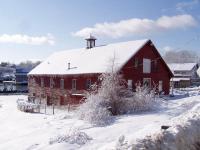Only the gunboat “Kennebec,” built by John Hilt, was launched in Thomaston during 1861 to serve in the US Navy. In the following year, only two ships were produced, one appropriately named “General McLellan,” after the popular major general, who reorganized the Union troops in 1861. By 1863 seven ships were sent down the ways, one of them named “E. Pluribus Unum” (“out of many, one,” the motto that appeared in the Great Seal of the United States of America in 1782) proudly on her stern.

Dunn and Elliot's Sail Loft, Thomaston, Maine 2008
Thomaston Historical Society
Following the close of the war, Dunn & Elliot (D&E), established a sailmaking business, making sails for the major shipbuilding firm of Chapman and Flint on the Georges River. By holding contracts to produce replacement sails, the firm enjoyed a steady supply of orders. Sail damage was guaranteed in the horrendous storms in passages around Cape Horn. The sail loft they built in 1875 still stands in its original location on Water Street at the foot of Green Street.

Ship Samuel Watts, Georges River, Thomaston, Maine 1870
Thomaston Historical Society
D&E also competed in the shipbuilding business. Thomas W. Dunn, John Elliot and George Elliot built ships under the name of E. Walsh and Co., following which the firm of T. W. Dunn & Co. was established in 1866 after the retirement of key figures in the former company. Dunn and Elliot was the eventual surviving corporation.
In the last quarter of the 19th century, the two major shipyards of Burgess and O’Brien and Captain Samuel Watts produced several Down Easters, a practical replacement for the clipper ships. With the coming of steam-driven vessels, sailing vessels underwent a change of design from square-riggers to schooners to stay competitive. Sail plans were greatly reduced, requiring fewer crewmembers, and ships’ holds were enlarged to carry more cargo.
<-Prev. Page ............................................................................... Next Page->